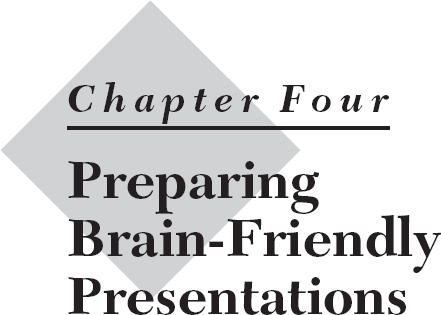
As you move from designing the opening exercises to the more central portion of your training program, you will almost certainly decide to present some of the information you wish to cover in a presentation-type format. Presenting or lecturing is the most efficient and lowest-cost method of transmitting information in a classroom setting and is useful for conveying information to a large group, especially when you need to get across general knowledge. It is a standard tool that remains in use in most training environments.
If you are committed to active training, however, you face a potential problem: Presentations put participants in a position of sustained, passive listening. This is even true when tools such as PowerPoint presentations are used to visually highlight key points. As we noted in Part One of this book, learning cannot occur simply by listening and seeing. It requires the person's own mental processing to take place. Therefore, presenting by itself will never lead to real learning.
Nonetheless, a presentation still can hold an important place in an active training program if you work to involve participants and maximize understanding and retention through participative techniques (Thiagarajan 2005). To accomplish these ends, a presentation has to be as carefully designed as any other training activity.
FIVE WAYS TO GAIN YOUR AUDIENCE'S INTEREST
The first design element ...
Get Active Training: A Handbook of Techniques, Designs, Case Examples, and Tips, 4th Edition now with the O’Reilly learning platform.
O’Reilly members experience books, live events, courses curated by job role, and more from O’Reilly and nearly 200 top publishers.

